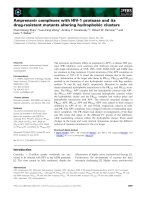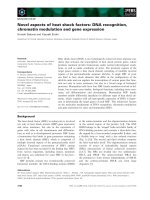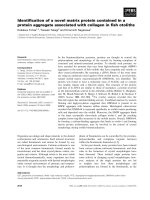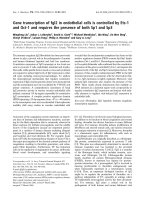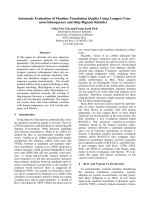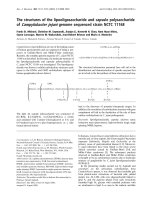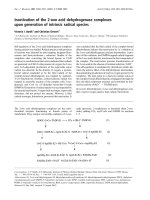Tài liệu Báo cáo Y học: Novel complexes of mammalian translation elongation factor eEF1AÆGDP with uncharged tRNA and aminoacyl-tRNA synthetase potx
Bạn đang xem bản rút gọn của tài liệu. Xem và tải ngay bản đầy đủ của tài liệu tại đây (277.83 KB, 8 trang )
Novel complexes of mammalian translation elongation factor
eEF1AÆGDP with uncharged tRNA and aminoacyl-tRNA synthetase
Implications for tRNA channeling
Zoya M. Petrushenko, Tatyana V. Budkevich, Vyacheslav F. Shalak, Boris S. Negrutskii
and Anna V. El’skaya
Institute of Molecular Biology and Genetics, National Academy of Sciences of Ukraine, Kiev, Ukraine
Multimolecular complexes involving the eukaryotic
elongation factor 1A (eEF1A) have been suggested to play
an important role in the channeling (vectorial transfer) of
tRNA during protein synthesis [Negrutskii, B.S. & El’skaya,
A.V. (1998) Prog. Nucleic Acids Res. Mol. Biol. 60, 47–78].
Recently we have demonstrated that besides performing its
canonical function of forming a ternary complex with GTP
and aminoacyl-tRNA, the mammalian eEF1A can produce
a noncanonical ternary complex with GDP and uncharged
tRNA [Petrushenko, Z.M., Negrutskii, B.S., Ladokhin,
A.S., Budkevich, T.V., Shalak, V.F. & El’skaya, A.V. (1997)
FEBS Lett. 407, 13–17]. The [eEF1AÆGDPÆtRNA] complex
has been hypothesized to interact with aminoacyl-tRNA
synthetase (ARS) resulting in a quaternary complex where
uncharged tRNA is transferred to the enzyme for amino-
acylation. Here we present the data on association of the
[eEF1AÆGDPÆtRNA] complex with phenylalanyl-tRNA
synthetase (PheRS), e.g. the formation of the above
quaternary complex detected by the gel-retardation and
surface plasmon resonance techniques. To estimate the
stability of the novel ternary and quaternary complexes of
eEF1A the fluorescence method and BIAcore analysis were
used. The dissociation constants for the [eEF1AÆGDPÆ
tRNA] and [eEF1AÆGDPÆtRNA
Phe
ÆPheRS] complexes were
found to be 20 n
M
and 9 n
M
, respectively. We also revealed a
direct interaction of PheRS with eEF1A in the absence of
tRNA
Phe
(K
d
¼ 21 n
M
). However, the addition of tRNA
Phe
accelerated eEF1AÆGDP binding to the enzyme. A possible
role of these stable novel ternary and quaternary complexes
of eEF1AÆGDP with tRNA and ARS in the channeled
elongation cycle is discussed.
Keywords: translation elongation factor; macromolecular
complexes; tRNA channeling; eukaryotic protein synthesis;
BIAcore analysis.
Aminoacyl-tRNA synthetase (ARS) and eEF1A are the
proteins that advance the translation elongation cycle. ARS
binds ATP, an amino acid and tRNA to produce aminoacyl-
tRNA. The molecules of eEF1A bind GTP and aminoacyl-
tRNA, and deliver the latter to the A site of a translating
ribosome. The main steps of protein biosynthesis are similar
in all living organisms. However, some peculiarities of the
higher eukaryotic translation have been revealed, among
which a compartmentalization of the translation apparatus
is of particular importance. There is an increasing body of
evidence for special structural organization of the protein
synthesis machinery in the higher eukaryotic cells. The
existence of multimolecular complexes of ARS [1], initiation
factors [2] and eEF1 [3,4], ribosome–ARS interactions [5–7],
and the association of translation components with cyto-
skeletal framework [8] are among the important signs of the
protein synthesis compartmentalization. Moreover, detailed
fluorescence-based measurements of translation in living
dendrites have visualized the mammalian protein synthesis
compartments in situ [9].
An important mechanism to put into effect the potential
advantages of the compartmentalization is thought to be a
channeling (vectorial transfer) of aminoacyl-tRNA/tRNA
from ARS to the elongation factor, ribosome and back to
ARS without dissociation into the surrounding medium
[10,11]. The channeling influences positively the transla-
tional efficiency because the number of nonspecific
searches is diminished, the effective concentrations of
translational components are increased and the leakage of
important compounds to another metabolic processes is
hampered [12]. The channeling is a mechanism operating
by the formation of intermediate complexes between
subsequent participants of the metabolic pathway. Deut-
scher and coauthors revealed that aminoacyl-tRNA and
tRNA were never free in the cytoplasm of the eukaryotic
cell [10–12]. ARS and eEF1A are supposed to play a main
role in the tRNA sequestering during the mammalian
translation [13].
Several examples of the functional interaction of eEF1A
with ARS resulting in the activation of the latter have been
described [4,14,15]. While the stimulation of the valyl-tRNA
Correspondence to A. V. El’skaya, Department of Translation
Mechanisms, Institute of Molecular Biology and Genetics,
150, Zabolotnogo Str., Kiev 03143 Ukraine.
Fax: +38 044 2660759, Tel.: +38 044 2660749,
E-mail:
Abbreviations: ARS, aminoacyl-tRNA synthetase;
eEF1A, eukaryotic translation elongation factor 1A (formerly EF-1a);
EF1A, prokaryotic translation elongation factor 1A (formerly
EF-Tu); FITC, fluorescein isothiocyanate isomer I; GMP-PNP,
guanosine-5¢-(b,c-imido)triphosphate; PheRS, phenylalanyl-tRNA
synthetase; RU, resonance unit.
(Received 10 May 2002, revised 11 July 2002,
accepted 13 August 2002)
Eur. J. Biochem. 269, 4811–4818 (2002) Ó FEBS 2002 doi:10.1046/j.1432-1033.2002.03178.x
synthetase activity by eEF1AÆGTP fits well for the
customary channeling scheme, representing transfer of
aminoacyl-tRNA from the enzyme to eEF1AÆGTP [4], the
explanation of the eEF1AÆGDP stimulating effect [14] is not
so obvious. We have hypothesized the activation of ARS by
eEF1AÆGDP could be a consequence of the interaction of
ARSwiththe[eEF1AÆGDPÆtRNA] complex [13]. A func-
tional meaning of the latter is supposed to accept deacylated
tRNA directly from the E site of 80S ribosome. We
postulated the following order of the interactions during
vectorial transfer of tRNA/aminoacyl-tRNA in the eukary-
otic elongation cycle [13]: [ribosomal E siteÆtRNA] (1) fi
[eEF1AÆGDPÆtRNA] (2) fi [eEF1AÆGDPÆtRNA]ÆARS
(3) fi [eEF1AÆGTPÆaminoacyl-tRNA] (4) fi [ribosomal
AsiteÆaminoacyl-tRNA] (5) fi [ribosomal P siteÆ
peptidyl-tRNA] (6) fi [ribosomal E siteÆtRNA] (1).
The existence of complexes 1, 4, 5 and 6 was well
documented and considered in all textbook schemes of
protein synthesis. The formation of noncanonical complex 2
has been demonstrated recently [16] but its thermodynamic
stability has not been determined. The idea of noncanonical
quaternary complex 3 assembling was based on the
stimulatory effect of eEF1AÆGDP on the activity of several
ARS [14], however, it remains to be shown directly.
In this work, the formation of a specific complex of
[eEF1AÆGDPÆtRNA] with PheRS was shown by the gel-
shift assay and surface plasmon resonance technique. High
stability of both novel ternary and quaternary complexes
of eEF1AÆGDP, [eEF1AÆGDPÆtRNA] and [eEF1AÆGDPÆ
tRNA
Phe
ÆPheRS], was observed, the dissociation constants
being determined as 20 n
M
and 9 n
M
, respectively. The
BIAcore analysis revealed a direct protein–protein interac-
tion within the quaternary complex 3. The sequence of
events in the channeled elongation cycle of protein synthesis
is discussed considering a putative supercomplex of ARS
and GDP/GTP exchanging subunits of eEF1.
MATERIALS AND METHODS
Materials
Q-Sepharose, SP-Sepharose and Sephacryl S-400 were
purchased from Pharmacia. Bio-Gel HTP hydroxylapatite
was from Bio-Rad. [a-
32
P]ATP, [
14
C]phenylalanine and
[
3
H]GDP were purchased from Amersham. CTP, GDP,
phosphoenolpyruvate and phosphoenolpyruvate kinase
were from Sigma. tRNA nucleotidyltransferase was isolated
from yeast as described [17]. Bovine catalase was from
Serva, rabbit glyceraldehyde-3¢-phosphate dehydrogenase
(GADPH) was from Boehringer Mannheim. Bacterial
EF1A was a gift from Dr I. Rublevskaya (this Department).
BIAcore 2000 apparatus, sensor chip CM-5 and reagents
for the surface plasmon resonance assay (Surfactant P20,
amine coupling reagents, N¢-ethyl-N¢-(dimethylaminopro-
pyl)carbodiimide, N-hydroxysuccinimide, ethanolamine
hydrochloride) were obtained from Pharmacia Biosensor.
Other chemicals were obtained from Sigma and Fluka.
Purification of rabbit liver PheRS and eEF1A
PheRS was isolated as described in [18], except that heparin-
sepharose was used instead of tRNA-sepharose. The
activity of PheRS in [
14
C]phenylalanyl-tRNA formation
was determined according to [14]. eEF1AÆGDP was purified
using the combination of gel-filtration and ion-exchange
chromatography as previously described [19]. GDP/
[
3
H]GDP exchange on the eEF1A molecule was performed
as described [19]. The purity of the enzymes was more than
95% according to the SDS/PAGE.
Preparation of bacterial EF1AÆGTP
To obtain the GTP form of bacterial EF1A, the factor was
incubated with 100 l
M
GTP in the incubation mixture
containing 25 m
M
Tris/HCl, pH 7.5, 50 m
M
NH
4
Cl, 10 m
M
MgCl
2
,1m
M
dithiothreitol, 0.5 m
M
EDTA in the presence
of 30 lgÆmL
)1
phosphoenolpyruvatekinaseand2m
M
phosphoenolpyruvate to remove traces of GDP. Incubation
was carried out at 30 °C for 15 min, and the EF1AÆGTP
preparation was used immediately.
tRNA
Phe
purification
Enriched tRNA
Phe
preparation was obtained from crude
rabbit liver tRNA by BD-cellulose chromatography. Indi-
vidual tRNA
Phe
was purified using Hypersil 5C4 column
(HPLC Gold system, Beckman). 3¢-
32
P-labeling of tRNA
Phe
was performed with tRNA nucleotidyltransferase according
to [20]. The labeled tRNA was purified in 8% polyacryl-
amide gel containing 8
M
urea.
Fluorescence measurements
The fluorescein isothiocyanate isomer I (FITC)-labeled
eEF1A was prepared according to [21] with some modifi-
cations. The protein (300 lg) was dialyzed for 2 h in
100 m
M
NaHCO
3
,pH 8.1,2m
M
MgCl
2
,25m
M
KCl, 20%
glycerol, 10 l
M
phenylmethanesulfonyl fluoride and 2 m
M
dithiothreitol at 4 °C. The stock solution of FITC was
added to the final concentration of 0.05 mgÆmL
)1
and the
incubation was continued for 40 min at 28 °C. The reaction
was quenched by addition of 2
M
NH
4
Cl (final concentra-
tion 50 m
M
) and the protein was separated from the dye by
gel-filtration on Sephadex G-25.
To obtain eEF1AÆGMP-PNP, the factor was incubated
with 200 l
M
GMP-PNP in the incubation mixture contain-
ing 25 m
M
Tris/HCl, pH 7.5, 5 m
M
MgCl
2
,50m
M
KCl,
13% glycerol and 2 m
M
dithiothreitol. Incubation was
carried out at 37 °C for 5 min directly before start of the
experiment.
Steady-state fluorescence measurements were made with
spectrofluorimeter Hitachi F-4000, Japan. Excitation mono-
chromator was set at 495 nm, emission wavelength was
525 nm.
Measurements were made in 1-mL quartz cuvettes
containing 800 lLof25m
M
Tris/HCl, pH 7.5, 5 m
M
MgCl
2
,50m
M
KCl, 13% glycerol, 2 m
M
dithiothreitol,
200 l
M
GDP (GMP-PNP) and 0.2 l
M
FITC-eEF1AÆGDP
(FITC-eEF1AÆGMP-PNP) at +24 °C. FITC-eEF1AÆGDP
or FITC-eEF1AÆGMP-PNP were titrated by increasing
concentrations of tRNA to measure K
d
of the [eEF1AÆGDP/
GMP-PNPÆtRNA] complex. An increase in the mixture
volume after tRNA addition did not exceed 3–5%. The data
were corrected for the background fluorescence and dilution.
To confirm complex formation, the polarization value
was determined after each tRNA addition. When plane
4812 Z. M. Petrushenko et al. (Eur. J. Biochem. 269) Ó FEBS 2002
polarized light is used to excite a fluorophore, molecules in
which the absorption oscillators are orientated parallel to
the direction of polarization will excite preferentially. The
polarized components of the emission can be used to
calculate a polarization value P ¼ I
||
– I
^
/I
||
+ I
^
(where
I
^
is the perpendicular component of fluorescence intensity
and I
||
is the parallel component of fluorescence intensity)
which is dependent on the rotational mobility of the
fluorophores, which in turn relates directly to its size;
therefore, larger fluorophores (with lower rotational mobi-
lity) exhibit higher polarization value under constant buffer
conditions.
Because the polarization change is a nonlinear function
[22], the effect of tRNA on a value of the perpendicular
component of fluorescence intensity (I
^
)wasmeasuredto
estimate the K
d
of the complex. The intensity was normal-
ized according to Eqn. (1):
I
?
norm ¼ I
0
?
À I
tRNA
?
=I
0
?
À 1 ð1Þ
where I
^
norm is the normalized intensity, I
0
?
is the fluor-
escence intensity before tRNA addition, I
tRNA
?
is the
intensity at given tRNA concentration. Data were curve-
fitted by nonlinear least squares to a bimolecular binding
isotherm according to the expression:
I
?
norm ¼ I
fin
?
 C=K
d
þ C ð2Þ
where I
fin
?
is the normalized intensity at final point of the
titration curve, C is the tRNA concentration, K
d
is the
dissociation constant.
Gel mobility shift assay
A possibility of eEF1AÆGDP in forming the complex with
deacylated tRNA was studied by nondenaturing PAGE.
The samples containing 10 l
M
eEF1AÆGDP were incubated
for 10 min at 37 °C in the presence of different concentra-
tions of tRNA in buffer containing 25 m
M
Tris/HCl
pH 7.5, 5 m
M
MgCl
2
,50m
M
KCl, 10% glycerol, 6 m
M
2-mercaptoethanol and 200 l
M
GDP. After the addition of
0.1 volume of 80% glycerol (containing traces of bromo-
phenol blue) the samples were applied to 5% polyacryl-
amide gel (19 : 1). PAGE was performed for 6 h at 4 °C
(40 mA, 100 V) in a buffer containing 100 m
M
Bes, pH 6.8,
10% glycerol, 10 l
M
GDP, 0.5 m
M
EDTA and 1 m
M
dithiothreitol. Protein bands were stained with Coomassie
brilliant blue.
The formation of the complex of [
32
P]tRNA
Phe
with
eEF1A and/or PheRS was studied on 0.7% agarose gel.
Three picomoles of tRNA were incubated with 10 pmol of
protein (eEF1A, PheRS or their mixture) at 37 °Cfor
10 min in 15 lLof25m
M
Hepes/KOH, pH 7.6, 5 m
M
MgCl
2
,100m
M
KCl, 10% glycerol, 2 m
M
dithiothreitol
and 100 l
M
GDP. The electrophoresis was run at 20 VÆcm
)1
(50 m
M
Tris/borate, pH 7.5, containing 1 m
M
EDTA) at
4 °C for 2 h. The radioactivity retained in the gel was
visualized by autoradiography with Kodak BioMax film.
Protein bands were stained with Coomassie brilliant blue.
Surface plasmon resonance analysis
The PheRS (250 000 Da) immobilization to the sensor
chip was carried out in a buffer containing 10 m
M
Hepes/KOH, pH 7.4, 150 m
M
NaCl, 3.4 m
M
EDTA,
0.005% P20-surfactant at a flow rate of 5 lLÆmin
)1
at
25 °C. The carboxymethyl dextran matrix of the sensor
chip was activated by a 30-lL injection of the mixture
of 0.2
M
1-ethyl-3-[(3-dimethylamino)propyl]carbodiimide
and 0.05
M
N-hydroxysuccinimide in water. PheRS coup-
ling was performed in 10 m
M
Hepes/KOH, pH 7.4 by a
20-lL injection of the protein (50 lgÆmL
)1
). Unreacted
N-hydroxysuccinimide ester groups were quenched by a
30-lL injection of 1
M
ethanolamine/HCl, pH 8.0. The
final level of PheRS immobilization was about 2500
resonance units (RU). Bovine catalase (2500 RU) was
immobilized to the sensor chip in the same way. While
studying the binding kinetics by BIAcore technique there
is a danger of deviations from the real data in case of
high surface density of an immobilized ligand. The mass
transport effect was hypothesized to reduce the effective
binding affinity for a soluble analyte [23]. However, a
comparative analysis [24] of the binding data for
immobilized influenza virus N9 neuraminidase (3000
RU surface density) with molecular mass 190 000 Da
(close to PheRS) and the Fab fragment of monoclonal
antibody of 50 000 Da (equal to eEF1A) with and
without the mass transport correction term at a flow
rate of 50 lLÆmin
)1
showed that there was no significant
difference in the fits indicating, in turn, that the values
measured at such a high flow rate did not contain
significant contribution from the mass transport.
To produce so-called ÔblankÕ chip for the assessment of
nonspecific adsorption of the analyte onto the sensing
surface the sensor chip was activated as described above
with the subsequent quenching of the active groups of
N-hydroxysuccinimide ester by 1
M
ethanolamine/HCl,
pH 8.0. Association and dissociation of eEF1AÆGDP or
[eEF1AÆGDPÆtRNA
Phe
] with PheRS immobilized surface
were measured in the running buffer containing 25 m
M
Hepes/KOH, pH 7.6, 5 m
M
MgCl
2
,100m
M
KCl, 10%
glycerol, 2 m
M
dithiothreitol, 100 l
M
GDP and 0.005%
P20-surfactant at the flow rate of 50 lLÆmin
)1
at 25 °C. The
solutions of eEF1AÆGDP or [eEF1AÆGDPÆtRNA
Phe
]
(30–500 n
M
) were injected for 200 s followed by dissociation
in the same buffer flow for 10 min. KCl (0.5
M
)wasusedto
regenerate a sensor chip after each binding event. The
concentration of the ternary complex was set by eEF1A
concentration.
BIAcore evaluation
The kinetic parameters were calculated using the kinetics
evaluation software package
BIAEVALUATION
3.0 (Pharma-
cia Biosensor). The theory of BIAcore measurement
technique and calculations has been extensively described
[25]. The formation of a surface-bound quaternary com-
plex [eEF1AÆGDPÆtRNAÆPheRS] was treated using
Eqn (3):
A+B À!
k
a
AB À!
k
d
A+B ð3Þ
where A corresponds to the immobilized ligand (PheRS),
B corresponds to analyte (eEF1AÆGDP or [eEF1AÆGDPÆ
tRNA]), k
a
is the association rate constant (
M
)1
Æs
)1
), k
d
is
the dissociation rate constant (s
)1
).
Ó FEBS 2002 Novel complexes of mammalian eEF1A (Eur. J. Biochem. 269) 4813
RESULTS AND DISCUSSION
Stability of the [eEF1AÆGDP/GMP-PNPÆtRNA] complexes
The stability of the noncanonical [eEF1AÆGDP/GMP-
PNPÆtRNA] complexes was studied by the fluorescence
method. The eEF1A preparation, containing approximately
one molecule of the fluorescence reagent (FITC) per one
protein molecule was obtained using an optimized labeling
procedure. The functional activity of the FITC-modified
eEF1A was verified by two independent techniques: the
GDP/[
3
H]GDP exchange and stimulation of poly(Phe)
synthesis on poly(U)-programmed 80S ribosomes in recon-
stituted cell-free translation system [26]. The FITC-eEF1A
activity was found to be 85–95% of the native protein
activity in both tests (data not shown). The proportion of
active molecules in the eEF1AÆGDP preparation, i.e.
amount of the protein molecules capable to form the
complex with tRNA, was estimated as in [27] by gel-shift
assay. Constant amounts of eEF1A were mixed with
different tRNA concentrations and run in nondenaturing
5% PAGE (Fig. 1). Under the conditions described in detail
in Materials and methods, eEF1AÆGDP moves rather
slowly (Fig. 1, lane 1) due to its high positive charge. It
did not fully enter the gel even after 6 h of electrophoresis.
As expected, the binding of negatively charged tRNA
during complex formation accelerates the protein band
movement (lanes 2–5). Lane 2 also shows that only at the
ratiooffactortotRNAlessthan2:1apartof
eEF1AÆGDP remains on the start. Thus, practically all
molecules of eEF1AÆGDP were found in the complex and
the amount of inactive eEF1A molecules being negligible.
The [eEF1AÆGDPÆtRNA] complex was shown earlier by
several independent qualitative methods [16]. Here its
formation during the factor titration with tRNA was
confirmed by the fluorescence polarization technique
(Fig. 2A). Indeed, gradual increase in the fluorescence
polarization seen upon the addition of tRNA shows a
change in the rotational mobility of the FITC-eEF1AÆGDP
in the free and tRNA-complexed state. The perpendicular
component of fluorescence intensity (I
^
) was normalized as
described in Materials and methods. To determine K
d
of the
[eEF1AÆGDPÆtRNA] complex the experimental points were
fit to a bimolecular binding isotherm (Fig. 2B) according to
Eqn (2). K
d
for this complex was estimated to be
20 ± 3.1 n
M
. Substitution of GDP by a nonhydrolyzable
GTP analog, GMP-PNP, diminished the affinity of the
factor for uncharged tRNA causing a more than fourfold
increase in the K
d
value (91.7 ± 3.6 n
M
).
The high stability of the [eEF1AÆGDPÆtRNA] complex
suggests a physiological meaning of its formation in vivo and
is in accordance with the earlier obtained data concerning
the specific sites of tRNA-factor interaction detected by
various footprinting assays [16]. These sites of interaction of
mammalian tRNA with eEF1AÆGDP were shown to
coincide with those of aminoacyl-tRNA in the complex
with EF1AÆGTP revealed by X-ray analysis [28].
Specific association of the [eEF1AÆGDPÆtRNA] complex
with PheRS
Nondenaturing gel-retardation procedure was used to
investigate a possibility of the formation of a stable complex
between [eEF1AÆGDPÆtRNA] and PheRS. The usage of the
polyacrylamide gel for the gel-shift experiments was
ineffective because of the high positive charges of eEF1A
and PheRS (pI are 9.1 and 8.2, respectively) and the high
molecular mass of PheRS resulting in low electrophoretic
mobility of the proteins and their complexes. Therefore, the
Fig. 2. Binding of tRNA to FITC-eEF1AÆGDP. The protein fluores-
cence polarization (A) and perpendicular component of fluorescence
intensity (B) of 0.2 l
M
FITC-eEF1AÆGDP were recorded in the pres-
ence of indicated tRNA concentrations (0–0.5 l
M
final) as described in
Materials and methods. Reactions were allowed to reach equilibrium
and data were corrected for the background fluorescence and probe
dilution.
Fig. 1. Electrophoresis of eEF1AÆGDP in nondenaturing conditions in
the presence of different tRNA concentrations. eEF1A (10 l
M
)and
indicated amounts of tRNA were incubated 10 min as described in
Materials and methods and the mixture was applied to 5% poly-
acrylamide gel. Electrophoresis was performed for 6 h at 4 °C(40 mA,
100 V) in a buffer containing 100 m
M
Bes, pH 6.8, 10% glycerol,
10 l
M
GDP, 0.5 m
M
EDTA and 1 m
M
dithiothreitol. Protein bands
were visualized by staining with Coomassie brilliant blue.
4814 Z. M. Petrushenko et al. (Eur. J. Biochem. 269) Ó FEBS 2002
[eEF1AÆGDPÆtRNAÆPheRS] complex formation was ana-
lyzed by the gel-retardation assay in 0.7% agarose (Fig. 3).
Mixing all four components of the complex led to a marked
delay of the [
32
P]tRNA zone (lane 5) which coincided with
the protein zone detected by Coomassie staining (lane 2).
To verify the specificity of the quaternary complex
formation, [
32
P]tRNA
Phe
was incubated with rabbit
GADPH or bovine catalase instead of PheRS (Fig. 4).
These proteins were chosen as controls due to high positive
charge of GADPH (pI 9.0) and molecular weight of catalase
(240 000 Da) like PheRS. Moreover, GAPDH is known to
possess nonspecific tRNA-binding properties [29]. Neither
GAPDH (lane 3) nor catalase (lane 5) was found to interact
with tRNA
Phe
under the same conditions and no quaternary
complexes were detected by the agarose gel electrophoresis.
The novel complexes found are specific for the mamma-
lian eEF1A because the bacterial EF1AÆGDP/GTP, like the
above control proteins, does not form any complex when
incubated with tRNA and PheRS (data not shown). It
would be expected because the prokaryotic EF1A is known
to possess a very low affinity for deacylated tRNA [30].
Stability of the quaternary [eEF1AÆGDPÆtRNA
Phe
ÆPheRS]
complex
The stability of the [eEF1AÆGDPÆtRNA
Phe
ÆPheRS] com-
plex was evaluated by the surface plasmon resonance
technique. The BIAcore instrument detects changes in the
surface plasmon resonance to monitor the interaction of
an immobilized ligand with analyte molecules in flow
solution [31]. PheRS was the immobilized ligand in all
experiments because the immobilization of eEF1A led to
a significant loss of its ability to bind tRNA. Therefore,
the ternary [eEF1AÆGDPÆtRNA
Phe
] complex was pre-
formed for 4 min at 25 °C in the running buffer and
injected as analyte. To estimate the contribution of
nonspecific adsorption property of the sensor surface,
control injections of the ternary complex over a blank
chip (see Materials and methods) were performed. A
background signal was automatically subtracted from the
sensograms obtained with immobilized PheRS. The spe-
cificity of the ligand–analyte interaction was verified by
the immobilization of bovine catalase instead of PheRS
over the sensor chip with subsequent injection of
eEF1AÆGDP in flow buffer. It resulted in a signal equal
to the control injection over a blank chip under the same
experimental conditions (data not shown).
Figure 5 shows the increase in the chip response level
upon addition of various concentrations of the [eEF1AÆ
GDPÆtRNA
Phe
] complex. The kinetic and equilibrium
constants determined in three separate runs with the
injection of [eEF1AÆGDPÆtRNA
Phe
] at six different concen-
trations are shown in Table 1.
It is noteworthy that the interaction of eEF1AÆGDP with
PheRS was observed in the absence of tRNA as well
(Fig. 6). It means that tRNA binding is not critically
important for the quaternary complex formation. However,
tRNA
Phe
accelerates the association phase of eEF1AÆGDP
binding to PheRS (see Table 1). In this case, the binding
could be interpreted as biphasic and the apparent K
d
value
was calculated taking into account not only hyperbolic but
also biphasic binding mode offered by the
BIAEVALUATION
3.0 software package. Similar K
d
values were obtained
by both procedures. As complete dissociation of the
[eEF1AÆGDPÆPheRS] and [eEF1AÆGDPÆtRNA
Phe
ÆPheRS]
complexes required significant period of time, the dissoci-
ation curves were extrapolated to zero by the software
package. The apparent K
d
for the [eEF1AÆGDPÆPheRS]
complex formation was 21 n
M
. The high affinity of eEF1A
for PheRS may be the reason of their co-purification from
rabbit liver extract during several chromatographic steps
Fig. 3. Nondenaturing agarose electrophoresis assay of the
[
32
P]tRNA
Phe
binding to PheRS and eEF1AÆGDP. tRNA
Phe
(3 pmol)
was incubated with 10 pmol of PheRS (lanes 1, 4) or the mixture of
10 pmol of PheRS and 10 pmol of eEF1A (lanes 2, 5) at 37 °Cfor
10 min. The electrophoresis was run for 2 h at +4 °C in 0.7% agarose
gel. Lane 3 shows [
32
P]tRNA
Phe
alone. The proteins were stained by
Coomassieblue(lanes1,2).[
32
P]tRNA
Phe
was visualized by autora-
diography (lanes 3, 4, 5). To save space, the tRNA
Phe
radioactive signal
isshowninaseparateboxbelow.
Fig. 4. Nondenaturing agarose electrophoresis of [
32
P]tRNA
Phe
in the
presence of eEF1AÆGDP and control proteins. tRNA was incubated
with eEF1A (lane 2), GADPH (lane 3), eEF1A and GADPH (lane 4),
bovine catalase (lane 5), bovine catalase and EF1A (lane 6) at 37 °C
for10min.Lane1showstRNA
Phe
alone. Each lane contained 3 pmol
of [
32
P]tRNA
Phe
and 10 pmol of protein.
Ó FEBS 2002 Novel complexes of mammalian eEF1A (Eur. J. Biochem. 269) 4815
(Turkovskaya, G.V. & El’skaya, A.V., unpublished obser-
vation). These data altogether seem to favor a possibility of
the protein–protein association in vivo.
Vectorial transfer of tRNA/aminoacyl-tRNA during
mammalian translation elongation cycle
Recently, the crystal structure of the [eEF1AÆeEF1Ba]
complex became available revealing a possibility of
competition between tRNA/aminoacyl-tRNA and eEF1-
Ba for the same site on the eEF1A molecule [32]. The
results presented here combined with these data, allowed
us to propose the tRNA channeling scheme in detail
(Fig. 7).
Taking into account rather low affinity of tRNA for the
E site of 80S ribosomes (the apparent K
d
is about 600 n
M
[33]), it is plausible to assume that the transfer of tRNA
from the E site to eEF1AÆGDP occurs due to the affinity
gradient (K
d
for [eEF1AÆGDPÆtRNA] is 20 n
M
, this study).
Furthermore, the ARS affinity for [eEF1AÆGDPÆtRNA] (K
d
is 9 n
M
, this study) is higher than that for free tRNA (K
d
in
the range of 100–200 n
M
[34,35]), which makes association
of the enzyme with tRNA bound to eEF1AÆGDP thermo-
dynamically favorable. In this quaternary complex, a
transfer of tRNA from the factor to ARS may occur. As
the quaternary complex [eEF1AÆGDPÆtRNAÆARS] (B) is
stabilized by the protein–protein and protein–tRNA inter-
actions, eEF1AÆGDP, being in the quaternary complex,
may interact with eEF1Ba, the factor of GDP/GTP
exchange. A possible association of ARS, eEF1A and
Table 1. Equilibrium and kinetic rate constants for [eEF1AÆ
GDPÆtRNA
Phe
]andeEF1AÆGDP binding to PheRS derived from the
BIAcore measurements.
k
a
(
M
)1
Æs
)1
)
k
d
(s
)1
)
K
d
(
M
)
[eEF1AÆGDPÆtRNA
Phe
]ÆPheRS 1.1 · 10
5
1.0 · 10
)3
9 · 10
)9
[eEF1AÆGDPÆPheRS] 3.8 · 10
5
0.8 · 10
)3
21 · 10
)9
Fig. 7. Scheme showing the tRNA/aminoacyl-tRNA channeling in the
translation elongation cycle. d, amino acid; small and large triangles,
tRNA and eEF1Ba, respectively.
Fig. 5. Biosensor assay of the quaternary [eEF1AÆGDPÆtRNA
Phe
Æ
PheRS] complex formation. PheRS was immobilized on the chip
as described in Materials and methods. Injections of the
[eEF1AÆGDPÆtRNA
Phe
] complex at concentrations of 60, 80, 125, 150,
250 and 500 n
M
(curves from bottom to top) were carried out for 200 s
at flow rate of 50 lLÆmin
)1
with the following dissociation of the
quaternary complex for 10 min. The sensograms show the kinetics of
the [eEF1AÆGDPÆtRNA
Phe
] complex binding to immobilized PheRS
and its subsequent dissociation from the immobilized enzyme.
Fig. 6. Biosensor assay of the [eEF1AÆGDPÆPheRS] complex formation.
PheRS was immobilized on the chip as described in Materials and
methods. Injections of eEF1AÆGDP were carried out for 200 s at flow
rate of 50 lLÆmin
)1
at concentrations of 40, 60, 100, 150, 250 and
500 n
M
(the curves from bottom to top) with the following dissociation
of the [eEF1AÆGDPÆPheRS] complex for 10 min. The sensograms
show the kinetics of the eEF1AÆGDP binding to immobilized PheRS
and its subsequent dissociation from the immobilized enzyme.
4816 Z. M. Petrushenko et al. (Eur. J. Biochem. 269) Ó FEBS 2002
eEF1Babc in a supercomplex is corroborated by the recent
data on the ARS contacts with different subunits of eEF1
[36]. eEF1Ba, which possesses higher than tRNA affinity
for eEF1A, displaces tRNA while the eEF1AÆARS and
tRNAÆARS contacts remain intact (C). Thus, aminoacyla-
tion of tRNA and GDP/GTP exchange in the eEF1A
molecule can occur at the same time (D). Then eEF1Ba
departs from eEF1A being ousted by newly synthesized
aminoacyl-tRNA (E) [32]. The finding that the complex of
eEF1A, eEF1Ba and nonhydrolyzable analog of GTP
could be dissociated by aminoacyl-tRNA rather than by
deacylated tRNA [37] favors the decrease in affinity
for eEF1A in the following order: [eEF1AÆGDPÆtRNA] <
[eEF1AÆeEF1Ba] < [eEF1AÆGTPÆaminoacyl-tRNA], sup-
porting the sequence of interactions described above. The
resulting quaternary complex [eEF1AÆGTPÆaminoacyl-
tRNAÆARS] dissociates rapidly giving the canonical ternary
complex [eEF1AÆGTPÆaminoacyl-tRNA] (F) and free ARS.
The scheme proposed and the results reported in this
paper are in good agreement with the observation that
tRNA in the eukaryotic cell is always bound to some
protein [11], never being in a ÔfreeÕ state. Further verification
of the sequence of events during tRNA/aminoacyl-tRNA
channeling involving the ARS molecule, as well as the
elucidation of eEF1AÆGDP action during dissociation of
deacylated tRNA from the E site of 80S ribosome is
presently underway.
ACKNOWLEDGMENT
We thank Ivan Gout (the Ludwig Institute for Cancer Research,
London, UK) for permanent support in BIAcore experiments and
Marc Mirande (Laboratoire d’Enzymologie et Biochimie Structu-
rales, CNRS, Gif-sur-Yvette, France) for helpful comments on the
manuscript. This work was supported by International Association
for the Promotion of Cooperation with Scientists from the New
Independent States of the Former Soviet Union (INTAS) Grant
96–1594 and by Ministry for Science and Technologies of Ukraine
Grants 5.4/73 and 5.7/0003. Z.M.P. was supported in part by the
Wellcome Trust Research Travel Grant and FEBS Short-term
Fellowship.
REFERENCES
1. Mirande, M. (1991) Aminoacyl-tRNA synthetase family from
prokaryotes and eukaryotes: structural domains and their impli-
cations. Prog. Nucleic Acids Res. Mol. Biol. 40, 95–142.
2. Asano, K., Clayton, J., Shalev, A. & Hinnebusch, A.G. (2000) A
multifactor complex of eukaryotic initiation factors, eIF1, eIF2,
eIF3, eIF5, and initiator tRNA
Met
is an important translation
initiation intermediate in vivo. Genes Dev. 14, 2534–2546.
3. Janssen,G.M.C.,vanDamme,H.T.F.,Kriek,J.,Amons,R.&
Mo
¨
ller, W. (1994) The subunit structure of elongation factor 1
from Artemia. Why two alpha-chains in this complex? J. Biol.
Chem. 269, 31410–31417.
4. Negrutskii, B.S., Shalak, V.F., Kerjan, P., El’skaya, A.V. &
Mirande, M. (1999) Functional interaction of mammalian valyl-
tRNA synthetase with elongation factor EF-1a in the complex
with EF-1H. J. Biol. Chem. 274, 4545–4550.
5. Irvin, J.D. & Hardesty, B. (1972) Binding of aminoacyl transfer
ribonucleic acid synthetases to ribosomes from rabbit reticulo-
cytes. Biochemistry 11, 1915–1920.
6. Popenko, V.I., Cherny, N.E., Beresten, S.F., Zargarova, T.A.
& Favorova, O.O. (1989) Immune electron microscope deter-
mination of the localization of tryptophanyl-tRNA synthetase in
bacteria and higher eukaryotes. Mol. Biol. (Moscow) 23, 1669–
1681.
7. Turkovskaya, H.V., Belyanskaya, L.L., Kovalenko, M.I. &
El’skaya, A.V. (1999) Renaturation of rabbit liver aminoacyl-
tRNA synthetases by 80S ribosomes. Int. J. Biochem. Cell Biol. 31,
759–768.
8. Stapulionis, R., Kolli, S. & Deutscher, M.P. (1997) Efficient
mammalian protein synthesis requires an intact F-actin system.
J. Biol. Chem. 272, 24980–24986.
9. Job, C. & Eberwine, J. (2001) Identification of sites for exponential
translation in living dendrites. Proc.NatlAcad.Sci.USA98,
13037–13042.
10. Negrutskii, B.S., Stapulionis, R. & Deutscher, M.P. (1994)
Supramolecular organization of the mammalian translation sys-
tem. Proc.NatlAcad.Sci.USA91, 964–968.
11. Stapulionis, R. & Deutscher, M.P. (1995) A channeled tRNA
cycle during mammalian protein synthesis. Proc. Natl Acad. Sci.
USA 92, 7158–7161.
12. Negrutskii, B.S. & Deutscher, M.P. (1991) Channeling of ami-
noacyl-tRNA for protein synthesis in vivo. Proc. Natl Acad. Sci.
USA 88, 4991–4995.
13. Negrutskii, B.S. & El’skaya, A.V. (1998) Eukaryotic translation
elongation factor 1a: structure, expression, functions, and possible
role in aminoacyl-tRNA channeling. Prog. Nucleic Acids Res.
Mol. Biol. 60, 47–78.
14. Negrutskii, B.S., Budkevich, T.V., Shalak, V.F., Turkovskaya,
G.V. & El’skaya, A.V. (1996) Rabbit translation elongation factor
1a stimulates the activity of homologous aminoacyl-tRNA syn-
thetase. FEBS Lett. 382, 18–20.
15. Reed, V.S., Wastney, M.E. & Yang, D.S.H. (1994) Mechan-
isms of the transfer of aminoacyl-tRNA from aminoacyl-tRNA
synthetase to the elongation factor 1a. J. Biol. Chem. 269, 3293–
3296.
16. Petrushenko, Z.M., Negrutskii, B.S., Ladokhin, A.S., Budkevich,
T.V., Shalak, V.F. & El’skaya, A.V. (1997) Evidence for the for-
mation of an unusual ternary complex of rabbit liver EF-1a with
GDP and deacylated tRNA. FEBS Lett. 407, 13–17.
17.Rether,B.,Bonnet,J.&Ebel,J.P.(1974)StudiesontRNA
nucleotidyltransferase from baker’s yeast. 1. Purification of the
enzyme. Protection against thermal inactivation and inhibition by
several substrates. Eur. J. Biochem. 50, 281–288.
18. Pailliez, J.P. & Waller, J.P. (1984) Phenylalanyl-tRNA synthetases
from sheep liver and yeast. Correlation between net charge and
binding to ribosomes. J. Biol. Chem. 259, 15491–15496.
19. Shalak, V.F., Budkevich, T.V., Negrutskii, B.S. & El’skaya, A.V.
(1997) A fast and effective method for purification of elongation
factor 1a from rabbit liver. Ukr. Biochim. J. 69, 104–109.
20. Silberclang, M., Gillum, A.M. & RajBhandary, U.L. (1977) The
use of nuclease P1 in sequence analysis of end group labeled RNA.
Nucleic Acids Res. 4, 4091–4108.
21.Weiel,J.&Hershey,J.W.B.(1981)Fluorescencepolarization
studies of the interaction of Escherichia coli protein synthesis
initiation factor 3 with 30S ribosomal subunits. Biochemistry 20,
5859–5865.
22. Ladokhin, A.S. (2000) Fluorescence spectroscopy in peptide and
protein analysis. In Encyclopedia of Analytical Chemistry: Instru-
mentation and Applications (Meyers, R.A., ed.), pp. 5762–5779.
John Wiley and Sons, New York.
23. Kortt, A.A., Oddie, G.W., Iliades, P., Gruen, L.C. & Hudson, P.J.
(1997) Nonspecific amine immobilization of ligand can be a
potential source of error in BIAcore binding experiments and may
reduce binding affinities. Anal. Biochem. 253, 103–111.
24. Kortt, A.A., Nice, E. & Gruen, L.C. (1999) Analysis of the binding
of the Fab fragment of monoclonal antibody NC10 to influenza
virus N9 neuraminidase from tern and whale using the BIAcore
biosensor: effect of immobilization level and flow rate on kinetic
analysis. Anal. Biochem. 273, 133–141.
Ó FEBS 2002 Novel complexes of mammalian eEF1A (Eur. J. Biochem. 269) 4817
25. Karlsson, R., Roos, H., Fagerstam, L. & Persson, B. (1994)
Kinetic and concentration analysis using BIA technology.
Methods 6, 99–110.
26. El’skaya, A.V., Ovcharenko, G.V., Palchevskii, S.S., Petrushenko,
Z.M., Triano-Alonso, F.J. & Nierhaus, K.H. (1997) Three tRNA
binding sites in rabbit liver ribosomes and role of the intrinsic
ATPase in 80S ribosomes from higher eukaryotes. Biochemistry
36, 10492–10497.
27. Bilgin, N., Ehrenberg, M., Ebel, C., Zaccai, G., Sayers, Z., Koch,
M.H.,Svergun,D.I.,Barberato,C.,Volkov,V.,Nissen,P.&
Nyborg, J. (1998) Solution structure of the ternary complex
between aminoacyl-tRNA, elongation factor Tu and guanosine
triphosphate. Biochemistry 37, 8163–8172.
28. Nissen, P., Kjeldgaard, M., Thirup, S., Polekhina, G., Reshet-
nikova, L., Clark, B.F.C. & Nyborg, J. (1995) Crystal structure of
the ternary complex of Phe-tRNA
Phe
,EF-Tu,andaGTPanalog.
Science 270, 1464–1472.
29. Sioud, M. & Jespersen, L. (1996) Enhancement of hammerhead
ribozyme catalysis by glyceraldehyde-3-phosphate dehydrogenase.
J. Mol. Biol. 257, 775–789.
30. Dell, V.A., Miller, D.L. & Johnson, A.E. (1990) Effects of
nucleotide- and aurodox-induced changes in elongation factor Tu
conformation upon its interactions with aminoacyl transfer RNA.
A fluorescence study. Biochemistry 29, 1757–1763.
31. Canziani, O., Zhang, W., Cines, D., Rux, A., Willis, B.,
Cohen, G., Eisenberg, R. & Chaiken, I. (1999) Exploring bio-
molecular recognition using optical biosensors. Methods 19,253–
269.
32. Andersen, G.R., Pedersen, L., Valente, L., Chatterjee, I., Kinzy,
T.G., Kjeldgaard, M. & Nyborg, J. (2000) Structural basis for
nucleotide exchange and competition with tRNA in the yeast
elongation factor complex eEF1A: eEF1Ba. Mol. Cell 6, 1261–
1266.
33. Graifer, D.M., Nekhai, S.Y., Mundus, D.M., Fedorova, O.F.
& Karpova, G.G. (1992) Interaction of human and Escherichia
coli tRNA
Phe
with human 80S ribosomes in the presence of
oligo- and polyuridylate templates. Biochem. Biophys. Acta 1171,
56–67.
34. Kaminska, M., Shalak, V. & Mirande, M. (2001) The appended
C-domain of human methionyl-tRNA synthetase has a tRNA-
sequestering function. Biochemistry 40, 14309–14316.
35. Merle, M., Trezeguet, V., Gandar, J.C. & Labouesse, B. (1988)
Effects of the ligands of beef tryptophanyl-tRNA synthetase on
the elementary steps of the tRNA
Trp
aminoacylation. Biochemistry
27, 2244–2252.
36. Sang, L.J., Gyu, P.S., Park, H., Seol, W., Lee, S. & Kim, S. (2002)
Interaction network of human aminoacyl-tRNA synthetases and
subunits of elongation factor 1 complex. Biochem. Biophys. Res.
Commun. 291, 158–164.
37. Janssen, G.M. & Mo
¨
ller, W. (1988) Kinetic studies on the role of
elongation factors 1b and 1c in protein synthesis. J. Biol. Chem.
263, 1773–1778.
4818 Z. M. Petrushenko et al. (Eur. J. Biochem. 269) Ó FEBS 2002


